This pages will give you some general information about praying mantises, like their morphology, their camouflage, their senses, their way of life and their natural habitat.
Morphology of a mantis
The morphology, or body plan, of a praying mantis is similar to that of many insects. It has six legs, two wings and two antennae. However, they have some special features which makes them unique among insects. First they are able to turn their head around like humans can. All other insects cannot turn their heads, their neck is too rigid to allow it. Furthermore praying mantids have modified front legs; these front legs are especially designed to catch prey and hold them tightly. These arms are very strong and equipped with pointy spikes to keep a firm hold on the prey.
Most adult praying mantids have wings (some species do not). Females usually cannot fly with their wings, but males can.
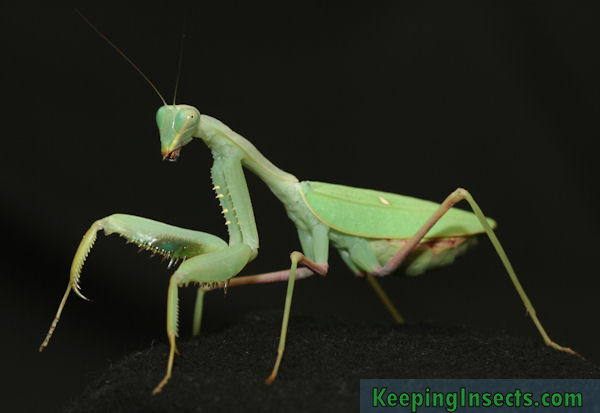
Here you can see the body plan of a mantis clearly. This is an adult female of Sphodromantis baccettii.
Camouflage and colors
Some mantis species depend on good camouflage to prevent predators from eating them, while others keep a more simple look. Well camouflaged mantids have many projections on their body in the shape of dead leaves, branches, flower pentals or even moss. Their colors can vary from brown, to green, white, pink, yellow or a mix of all colors. The more straightforwards looks are simply green, brown or sandy colored but without any special modifications.
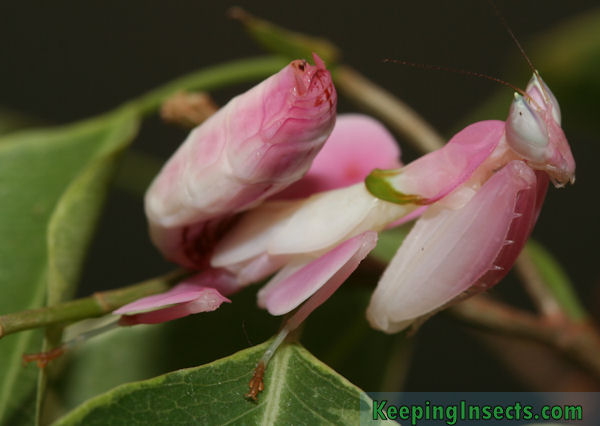
This orchid mantis has extraordinary camouflage
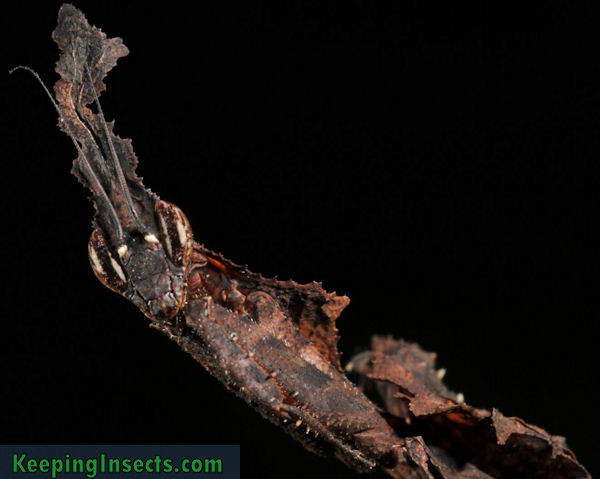
This Ghost mantis has strange shapes on its head and body to mimic dead leaves
The senses of a mantis
Praying mantids have as many senses as we do; sight, smell, taste, feeling and hearing. However, they mostly depend on sight. Their sense of sight is amazing compared to the abilities of other insects. They are one of the only kind of insect that has stereo-vision; it can look with two eyes at the same spot making it possible to judge distances very accurately. Their other senses are weak compared to ours; their sense of smell is mostly limited to smelling specific pheromones that members of their own species emit. Their sense of hearing is weak, but very special in the insect world. Almost all insects cannot hear as we do, they can only sense vibrations. But praying mantids actually have one ear, in the middle of their abdomen, that can sense the high-pitched tones of a bat! This ear is especially developed to pick up the echolocation calls of bats, the ear cannot hear other tones. Because of this ear, a flying mantis can hear it when a bat is chasing him in the air. When a flying mantis hears the call of the bat at a close distance, it will suddenly make a turn and let itself drop to the ground. This saves the life of the mantis, as bats are a very common predator of flying insects.
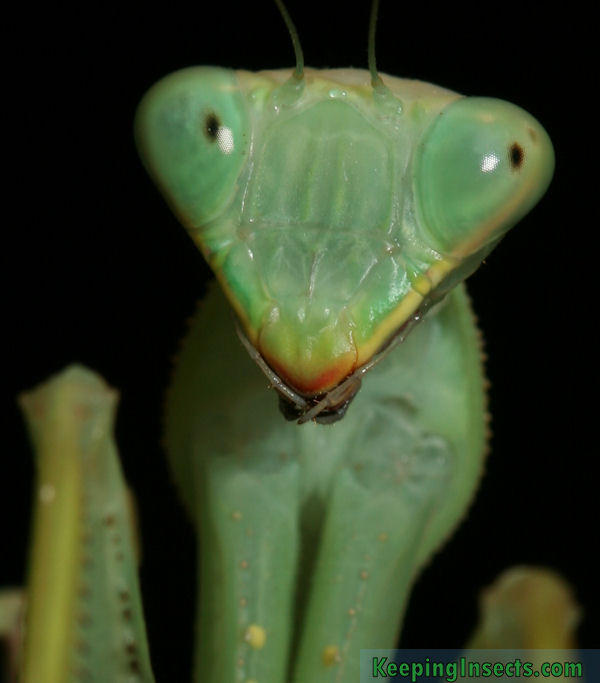
The eyes of a mantis are very big and directed forward, to ensure good stereo-vision.
Development and growth
Praying mantids are part of the hemimetabola group of insects; this means they do not undergo a complete metamorphosis. A complete metamorphosis is that of a butterfly or beetle; first you have a caterpillar or larvae, then a pupa (cocoon) and then the adult insect. This adult looks nothing like the first stage of the life cycle. In mantids and other hemimetabola, the newly born insects already resemble the adults. In praying mantids, the newborn nymphs are almost the same as the parents except their size, color and their wings. These mantis nymphs shed their skin around 6 – 9 times before reaching adulthood. The number of molts depends on the species and the sex of the mantis. Every time the mantis sheds its skin, it will grow. Because of its rigid outer skeleton (skin) the mantis cannot grow in between molts.
Every nymph stage is indicated with a number; newborn nymphs are called L1. After they shed their skin for the first time, they are called L2. This goes on until the mantis is almost adult. When it has only one molt to go before reaching adulthood it is often called subadult, although you could still indicate its life stage by its L-number.
Praying mantis eggs are deposited in the form of an ootheca; this is a cluster of eggs enclosed by foam. This foam will quickly harder after the female has produced the ootheca, thereby protecting the eggs inside from cold, predators and from desiccation.
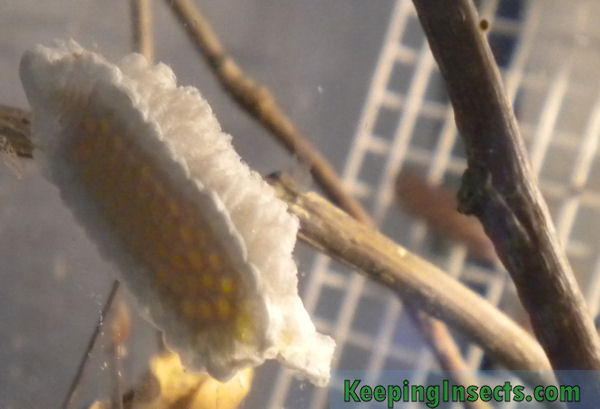
This is an ootheca that has been deposited on glass. The small rounds are eggs seen through the glass.

This is the skin a mantis leaves behind every time it molts.
Video of mantis nymphs hatching:
Natural habitat and natural behavior
Praying mantids occur on all continents except Antarctica, therefore their natural habitat is very diverse. There are praying mantis species that occur in trees, bushes, grassland and even rocky or sandy desert environments. They can occur in wet ecosystems or in very dry systems. Their way of life strongly depends on its habitat and the species, but generally a praying mantis is a sit-and-wait predator. This means it will stay in one place and scan the environment for potential prey. When it spots its prey, some species will actively walk towards it to catch it. Other species will continue to wait until the prey is close enough to be caught.
When praying mantises become adult, the female will generally remain at her position while the male will search for her. The male is able to fly, while most female praying mantids are not. The female will emit a pheromone when she is ready to mate. The male can smell this pheromone of his own species from miles away and will fly towards her.

